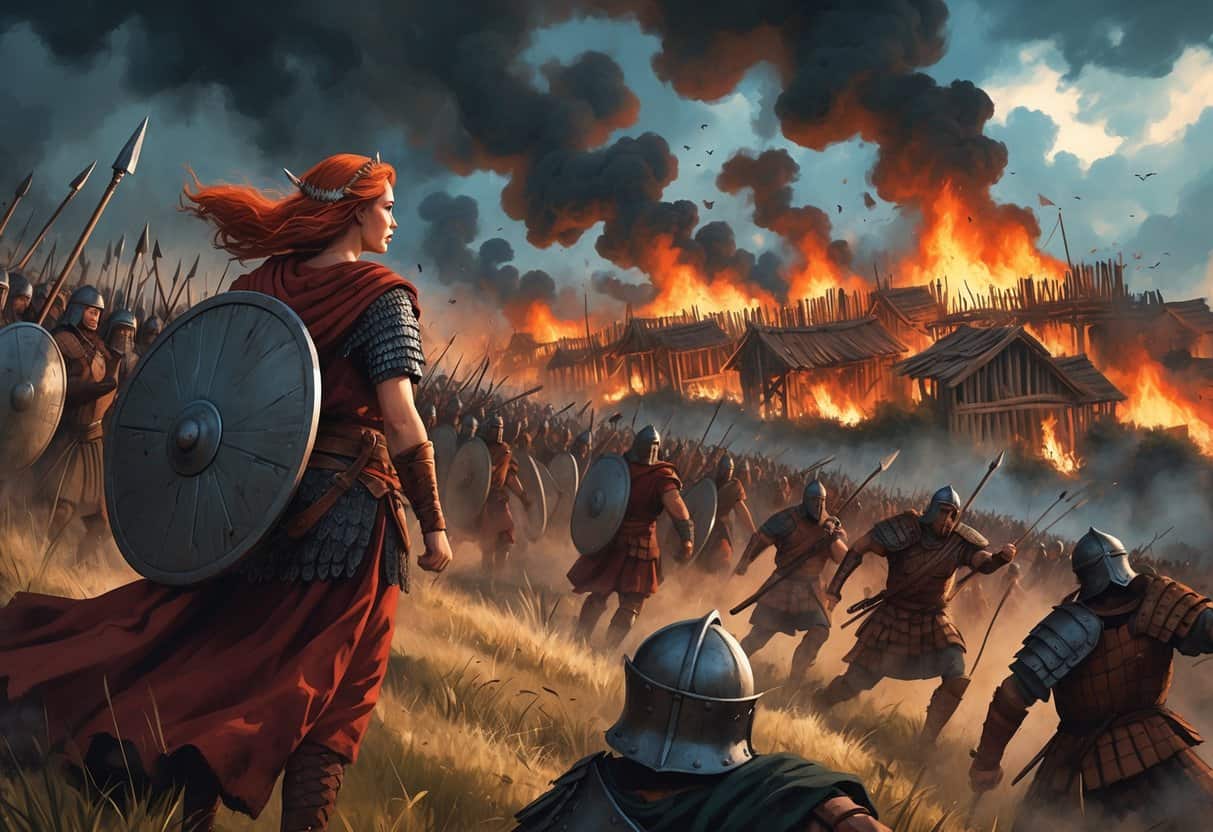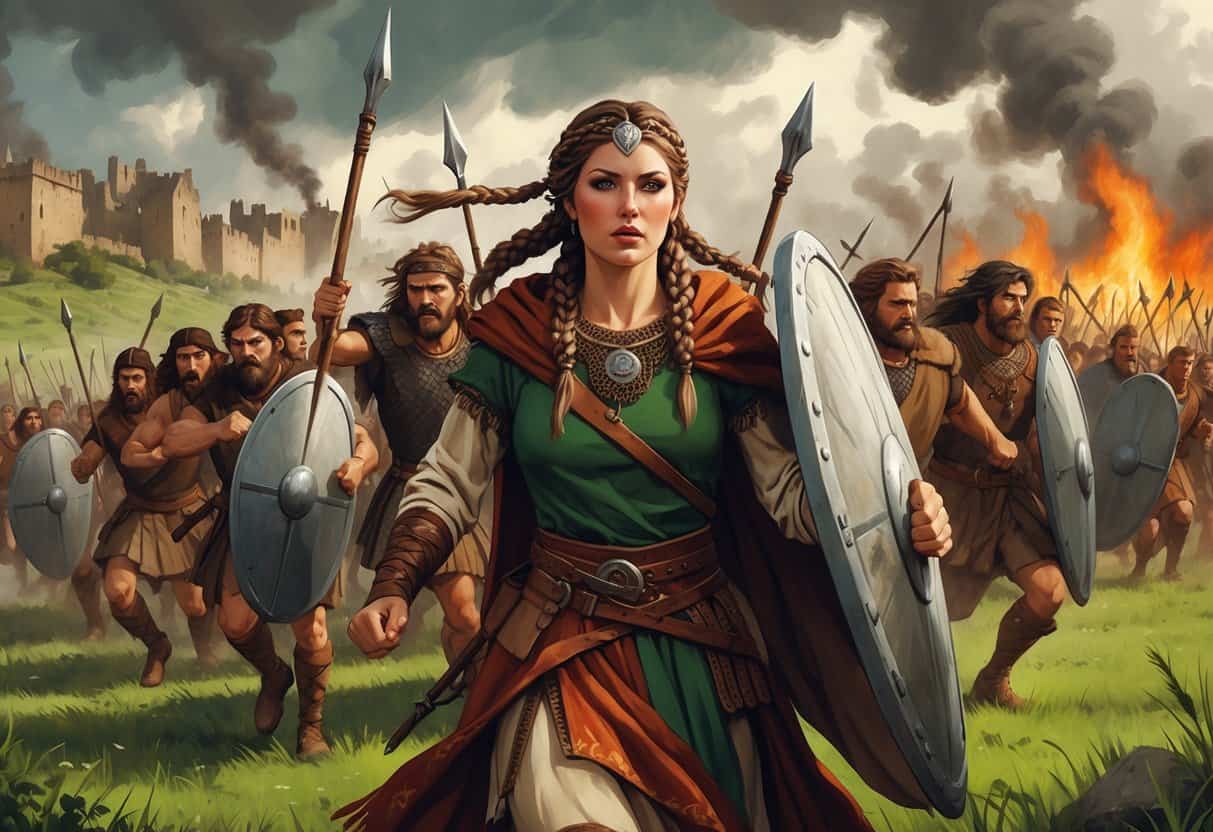Queen Boudica led one of the fiercest uprisings against Roman rule in ancient Britain. After the Romans treated her family and people brutally, she managed to unite several tribes to strike back.
Her forces burned Roman towns and destroyed cities in direct response to Roman cruelty and control.

Boudica’s army attacked and burned important Roman cities like Colchester and London, leaving massive destruction in their wake. These attacks really showed the anger and determination of the native Britons against their Roman occupiers.
The revolt led by Boudica gives us a glimpse into how far locals would go to fight for their freedom.
Key Takeaways
- Boudica led a major rebellion after Romans mistreated her family and people.
- Her army destroyed several key Roman cities during the revolt.
- The uprising left a lasting mark on Roman rule in Britain.
Background: Queen Boudica and Roman Britain

Let’s look at how Boudica’s tribe and family fit into the bigger picture under Roman rule. The Iceni tribe lived in eastern Britain before Rome took over.
The Romans saw Britain as fresh territory to conquer, which, not surprisingly, led to tension with native tribes.
Rise of the Iceni Tribe
The Iceni were a Celtic tribe living in what’s now Norfolk and Suffolk. Think of them as local leaders with their own traditions and land.
Before Rome showed up, the Iceni had a strong, independent culture. They controlled trade and farming nearby.
The tribe was wealthy, respected, and pretty influential among their neighbors.
When Roman troops landed in Britain around 43 CE, the Iceni first played along as allies. Rome let them keep some freedom under their own kings, but gradually pushed for more control over land and taxes.
This slow squeeze made resentment grow.
Roman Expansion and Administration
Rome turned Britain into a province under Emperor Augustus. They ruled either through local leaders or direct governors, always backed by their armies.
Britain was valuable for its metals and farmland. Romans built forts and towns to hold their grip.
Governors like Gaius Suetonius Paulinus worked hard to crush uprisings and enforce Roman law. Occupation meant heavy taxes and strict rules for locals.
Many Britons saw their way of life slipping away, and that tension just kept building.
Role of Prasutagus and Boudica
Prasutagus was king of the Iceni as Rome’s power tightened. He tried to keep the peace by staying on Rome’s good side.
He left a will naming his two daughters and the Roman emperor as heirs, hoping to protect his family and tribe.
After Prasutagus died, the Romans ignored his wishes. They seized Iceni lands and property.
Boudica, his wife, was publicly humiliated, and their daughters suffered horrible abuse.
This cruelty pushed Boudica to rebel. She became a symbol of resistance against Roman injustice.
Catalysts for Rebellion: Causes of the Boudican Revolt
Let’s get into what really drove Queen Boudica and her people to rise up against Rome. The main triggers were how the Romans treated the Iceni and Trinovantes, pressure from Roman control, and the fallout after Prasutagus’s death.
Treatment of the Iceni and Trinovantes
The Iceni, led by Prasutagus, had an agreement with Rome to keep their land and status after his death. But Roman settlers ignored this deal.
They took over Iceni lands and property. Boudica was whipped in public, and her daughters were raped.
The Trinovantes, a nearby tribe, got similar brutal treatment. Many were forced into slavery.
The Romans’ violence—especially against women and children—was a huge insult to the Britons’ warrior society.
Roman Oppression and Social Tensions
Roman officials imposed heavy taxes and controlled local resources with a tight grip. Tribes like the Iceni and Trinovantes lost their independence and suffered under Roman law.
Roman soldiers and settlers grabbed land, enslaved locals, and ignored tribal customs.
This created a lot of resentment. Romans didn’t care much for the Britons’ traditions.
Social tensions soared as Roman rule tightened its hold. Settlers gained power, while native Britons lost influence.
This imbalance only made the unrest worse.
The Death of Prasutagus and Boudica’s Leadership
Prasutagus died hoping his kingdom would pass peacefully to his family. Roman law had other ideas.
They took full control, ignoring any previous agreements.
Boudica, pushed by betrayal and personal suffering, stepped up as leader. She rallied the Iceni, Trinovantes, and other angry tribes to fight Rome.
Her leadership united the tribes with one goal: push back Roman control.
Queen Boudica’s Campaign: Destruction of Roman Cities
Let’s look at how Boudica led her forces to attack major Roman settlements, causing chaos and destruction. She focused on key Roman cities in East Anglia, hitting the heart of Roman power.
Attack on Camulodunum (Colchester)
Camulodunum—now Colchester—was Boudica’s first target. It was a Roman settlement and the former capital of Roman Britain.
The city had a temple to Emperor Claudius, which locals saw as a symbol of Roman oppression.
Boudica’s army struck Camulodunum when it was poorly defended. Her forces burned buildings, killed many Romans, and destroyed much of the city.
The temple of Claudius was besieged, and defenders were trapped inside for two days before the city finally fell.
This victory gave Boudica’s rebellion a big boost.
Destruction of Londinium (London)
After Camulodunum, Boudica moved on to Londinium—later known as London. It was smaller but important for trade and Roman administration.
Her forces sacked Londinium, burning homes, shops, and key buildings. The city was left in ruins.
Many Roman civilians and soldiers died or were captured during the attack.
The destruction of Londinium sent shockwaves through Roman Britain. It proved Boudica’s rebellion was a real threat.
The Roman Response and Legacy of the Revolt
So, how did the Romans react to Boudica’s uprising? The key battle that ended it all, and what we know from ancient sources and archaeology, shed light on the aftermath.
Battle of Watling Street
The Battle of Watling Street was the final showdown between Boudica’s forces and the Romans. It happened around 60 CE on a Roman road called Watling Street.
Even though they were outnumbered, Roman soldiers used strong defenses and discipline to defeat the rebels.
Boudica’s army, made up of several Celtic tribes, was huge but less organized. The Romans, led by Suetonius Paulinus, formed tight lines and broke the rebel charges.
The battle crushed the rebellion and ended Boudica’s campaign.
Role of Suetonius Paulinus and the Roman Army
Suetonius Paulinus was the Roman governor and commander during the revolt. Before the rebellion, he was busy attacking the Isle of Anglesey, a Celtic stronghold.
When news of Boudica’s uprising reached him, he hurried back with his troops.
Paulinus chose the battleground at Watling Street, using the terrain and his army’s skills to their advantage. The Romans suppressed the revolt with harsh punishments, making sure no other tribe dared to rise up.
The discipline and experience of the Roman army, built up over decades, helped them keep control—even during this crisis.
Historical Sources and Archaeological Evidence
Most of what we know about Boudica’s revolt comes from ancient writers like Cassius Dio and Tacitus. Cassius Dio, a Roman senator, wrote his account years after the events and, honestly, you can feel the bias in his words.
Tacitus, also a senator and historian, was a bit closer in time to the revolt. His version gives us a different angle, maybe a little less colored by hindsight.
Archaeology backs up a lot of what they wrote. In old Roman cities—Camulodunum, Londinium (that’s London), and Verulamium—you can see destruction layers that line up with Boudica’s attacks.
The combination of these written accounts and what archaeologists dig up really paints a vivid picture of how the revolt played out in ancient Britain.